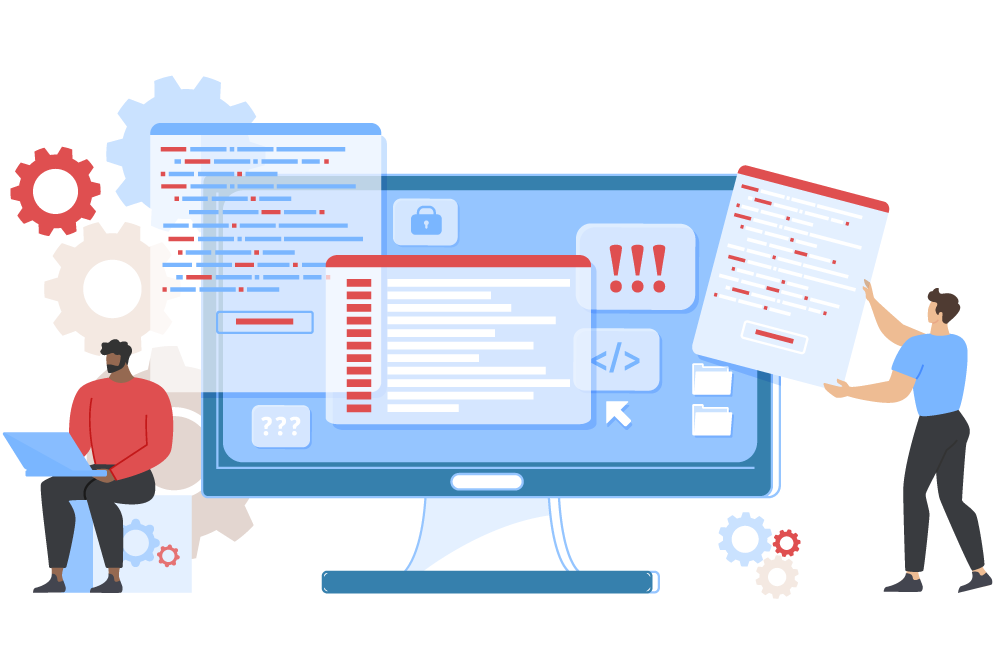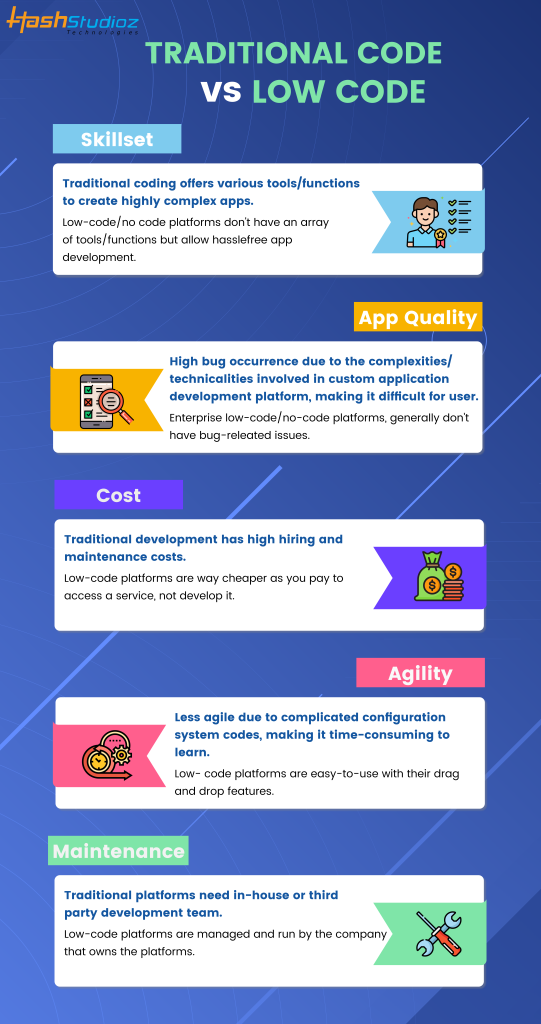Low-code applications provide significant advantages for integration, which is vital when developing applications that are able to seamlessly connect various systems and service. These are the main benefits: Pre-built Connectors and APIs:
Connectors that are wide-ranging Low-code platforms come with an extensive collection of connectors that are pre-built for popular enterprise system (e.g. CRM, ERP databases, cloud services). This allows for easier integration with systems.
API Integration - A lot of low-code platforms have built-in API integration, allowing developers to easily access other data sources or external services.
Easy to use
Drag-and-Drop Integration Tasks for integration can typically be completed using drag-and-drop interfaces, making it possible for both developers and non-developers to set up complex integrations without writing extensive code.
Visual Workflow Builders Visual Workflow Builders: These tools can be utilized to design workflows, data flows, and integrations. They help with understanding and setting them up more efficiently.
Standardized Integration Methods:
SOAP/RESTful Services Support: Web services that use standard protocols, like SOAP/REST, allow for easy integration of various different systems and applications.
OData and other Standards The support for standards such as OData allows access and manipulation of data across platforms and applications.
Real-Time Data Synchronization:
Real-Time Integrations: Low-code systems are capable of handling real-time data sync between systems and applications. This ensures that data is always up-to-date and consistent throughout the organization.
Event-Driven Architecture: Certain platforms can support event-driven architectures. enabling applications to respond to events in real-time, which is vital for dynamic and interactive applications.
Legacy System Integration:
Interconnecting old Systems and new Systems Low-code platform often provides the tools needed to integrate with older systems. This allows organizations to upgrade their IT Infrastructure without overhauling the existing systems.
Data Migration Tools: Built-in software helps transfer data from older applications to new ones that are built on platforms that use low-code.
Third-Party Services Integration:
Cloud Services Integration: The seamless integration of cloud services like AWS Azure, Google Cloud facilitates the easy deployment and scaling-up of applications.
Business Application Integration: Low-code platforms have the ability to integrate with various business applications, such as Salesforce, SAP, Microsoft Dynamics and more. This allows for a seamless workflow that spans different business processes.
Simplified Data Management:
Data models that are unifying: A few platforms provide low-code support for unified data models to simplify data management across different systems.
Data Connectors are pre-configured data connectors which provide rapid access to sources of data, and allow manipulation.
Security and compliance:
Secure Integrations: Low-code platforms ensure that integrations adhere to security protocols and standards, assisting to safeguard data while in transit as well as at rest.
Features for Compliance - These platforms have features to ensure the integrations are compliant with the regulatory regulations.
Extensibility:
Low-code platforms allow for the creation of customized scripts and codes to satisfy more complicated integration requirements. This flexibility is available without compromising user-friendliness.
Plug-in Ecosystems: An eco system of plugins and extensions lets users expand their integration capabilities. They can also add additional features whenever they want.
The overall low-code platform's capabilities to integrate make it a powerful instrument for developing interconnected apps that are scalable and efficient. They facilitate the process of connecting disparate systems, enhance data flow, and permit enterprises to embrace new technologies while leveraging existing ones. Have a look at the most popular Low-code Platform for application development for site examples including app modernization, database in azure, push notifications, application modernization, develop cross platform mobile app, application modernisation, rad application development, app dev platform, app dev platform, develop web app and more.

The Advantages Of Low-Code Development In The Areas Of Governance And Security
Low-code applications offer a number of advantages when it comes to governance and security, which is essential to ensure that applications are compliant and secure. They also ensure that they are well-managed throughout their lifecycle. Here are a few key advantages.
Unified Management Console - Low-code platforms provide a central management console to allow administrators to control and supervise all applications. This allows for consistent governance across the entire organization.
Role-Based Access Control RBAC : These platforms usually include robust roles-based access controls, which enable administrators to create and enforce policies. It makes sure that only users with permission can modify or access specific parts of the application.
Conformity and Regulatory Conformity:
The advantages of conformity: Many platforms that make use of low-code are constructed to comply to industry standards. They provide templates and tools to ensure that applications comply with these requirements.
Audit Trails and Logging Audit trails and logs that are comprehensive are typically integrated, allowing organizations to track changes, monitor access and ensure compliance with internal and external regulations.
Improve Security Measures
Data encryption. Low code platforms typically provide encrypted data built-in, both in transit and when in rest. This helps protect sensitive information.
Security Certifications: A lot of low-code service providers have security certificates (e.g., ISO 27001, SOC 2) that prove their compliance with high security standards, providing extra security for users.
Automated Security Updates
Regular Security Updates and Patches : Low-code platform handle automatically security updates, patches and updates. Applications are therefore protected from the latest threats without requiring manual intervention by developers.
Security Monitoring: Tools for continuous security monitoring are included. They offer immediate alerts and insights into possible security issues.
Data Governance
Data Access Policies: These platforms permit organisations to create and enforce policies on data access which ensure that data is accessible to authorized users and is properly used.
Data Masking and anonymization The built-in tools that hide and anonymize data helps safeguard sensitive data when working in testing or development environments.
Consistent Application Management:
Pipelines for deployment and development: Low code platforms offer integrated development and deployment pipelines which contain security inspections. They ensure security is maintained throughout the entire life cycle of an application.
Version Control: Integrated version control helps manage modifications and makes sure that modification to the application can be monitored and reversed if needed, maintaining the integrity of the application.
User Authentication & Authorization
Single Sign-On (SSO): Single sign-on support and other advanced authentication techniques makes managing users easier and increases security.
Multi-Factor Authentication Most platforms can support multi-factor Authentication, which adds an extra layer of security when accessing applications.
Monitoring of Policy Enforcement:
Low-code platforms come with policy templates predefined that can assist organizations in the implementation of governance policies and security policies.
Compliance Monitoring Tools The tools offer regular monitoring and report on compliance status, making it much easier to spot and fix any issues that could arise.
Integration into Existing Security Infrastructure
Seamless Integration: Platforms with low-code technology are built to integrate seamlessly with existing tools and infrastructure such as SIEM (Security Information and Event Management solutions) and firewalls.
API Security API Security: API security features are built-in to make it possible to integrate with external systems, securing data and maintaining integrity of the applications.
Training and the best practices
Guided Best Practices: Many platforms provide guidelines and best practices for developing secure applications and help non-developers comply with security standards.
Certain low-code companies offer security education to help users build and maintain secure apps.
Overall, governance and application security advantages guarantee that applications are developed and maintained in a secure manner while remaining in compliance with the regulations and under control. These platforms have the frameworks and tools necessary to secure sensitive data and enforce policies, as well as maintain regulatory compliance while simplifying managing and monitoring. Have a look at the top rated what is it worth on Enterprise application development with Low-code Platform for site advice including database in azure, application development platforms, app platforms, push alerts, cross platform app development, push notifications, app dev platform, multiplatform mobile app development, low code platforms, develop web app and more.

Advantages Of Low-Code Application Development In Terms Of Vendor Support And Community
Low-code applications development platforms are a great method to gain vendor support as well as community involvement. Both of these factors are essential to ensure an effective implementation and continuous maintenance of the app. Here are some key benefits.
Comprehensive Technical Support:
Support Teams with Dedicated Support: Many low-code platforms have access to dedicated support teams that can help in technical problems, troubleshooting, and guidance, ensuring that all issues are solved quickly.
Some vendors provide 24/7 support. This is advantageous for companies operating across time zones.
Training and Onboarding:
Training programs that are structured: Vendors offer structured courses like webinars or courses for certification. This helps users quickly get to grips with the platform.
Personalized Onboarding: Many companies offer personalized onboarding to assist new customers use the platform efficiently and adapt it to their specific requirements.
Updates and Enhancements, Regularly and Improvements:
Continuous Improvements: Low-code providers regularly release updates with improvements in performance as well as new features and security patching, to keep the platform up-to-date.
Feedback Integration Vendors incorporate user feedback into the development cycle to ensure that the platform is updated in response to the changing requirements.
Comprehensive Documentation:
Detailled Documentation: Comprehensive and well-organized documentation is typically available that covers everything from basics to advanced customization, which assists users in finding solutions without assistance.
API References In-depth API documentation lets developers customize applications and integrate low-code platforms with other systems.
Professional Services and Consulting:
Expert Consulting: Many companies offer consulting services to aid users with complicated design and implementation, as well as strategic planning.
Custom Development Services: A few vendors offer custom development services to develop specific features or integrations that are not available out-of-the-box.
Community Support
Active User Communities
Discussion boards and forums Discussion boards and forums: Many low-code platforms have vibrant online communities that let users ask questions, exchange solutions and work together on best practices.
Local and virtual User Groups, as well as Meetups, provide opportunities for users to share their experiences, share their knowledge with others, and network.
Collaboration and Knowledge Sharing:
Community-Contributed Resources: Users often share templates, modules, and extensions that they have developed, which can be reused or adapted by others, accelerating development and innovation.
Crowdsourced Solution Finding: The collective experience and wisdom of a group could be a valuable resource in solving difficult problems.
Learning and Development
Community-led Training: A lot of groups organize workshops, sessions for training, and webinars. These are usually led by experienced users, who share practical knowledge as well as advanced techniques.
Online Tutorials and Courses Community members regularly develop and publish online tutorials, courses, and how-to guides, enhancing the educational resources accessible to all users.
Feedback and Influence
Product Feedback: Many forums have channels for giving feedback to manufacturers. This feedback can affect the design of new features or improvements.
Beta Testing Programs. Active community members can take part in beta-testing programs. They will be given an early introduction to the new features of the platform and the chance to influence its evolution.
Recognition and Support
Community Recognition Programs - Many vendors have recognition programs that acknowledge the efforts of active members of their community and include MVP (Most Valuable Professionals) programs.
Support from peers: Community members are often willing to offer support to peers, providing their knowledge and advice to those who may be less knowledgeable. They help create a supportive atmosphere by encouraging collaboration and a supportive atmosphere.
Overall, the combination of strong vendor support and active and engaged communities. They provide an extensive environment to support of low-code applications development. Users will be able to access the resources, experts, and collaboration opportunities they need to develop applications, deploy, keep them up to date, and enhance their applications.
